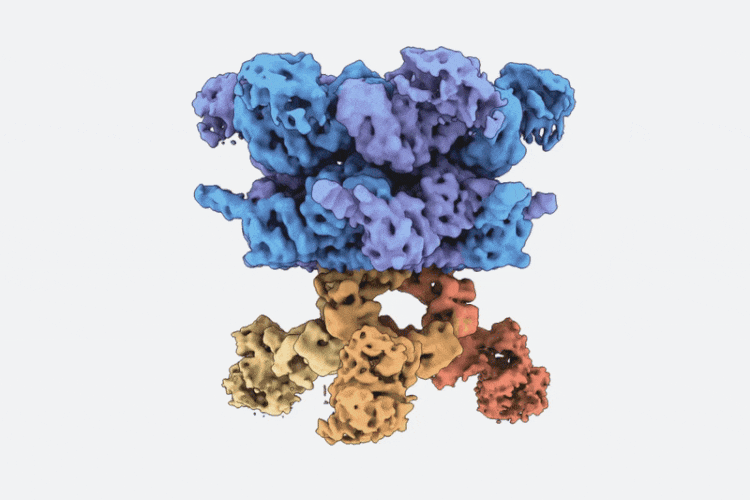
Three dimensional cryo-EM structure of VCP (blue and purple) bound to three VCPIP1 promoters (red, orange, and yellow). (Courtesy of Kapoor lab)
Healthy cells are constantly breaking down proteins and building up new ones with the help of enzymes aptly named unfoldases, because they unravel proteins tagged for destruction or recycling. Now, a new electron microscopy study demonstrates how VCP, one such unfoldase, physically interacts with tag removal enzymes, called DUBs. The findings show how these two enzymes work in tandem to process proteins, and may have implications for the study of diseases such as those linked to neurodeneration.
"VCP dysfunction is linked to neurodegenerative disorders, such as Alzheimer's," says first author Lauren Vostal, a graduate student in the laboratory of Tarun Kapoor and now a senior scientist at Boehringer Ingelheim. "Actually being able to see physical contact between VCP and DUBs can provide insight into how these two enzymes are coordinated to regulate protein degradation."
Unfolding and cutting
Cells maintain proteostasis-a careful balance of the number of proteins present-through a series of coordinated mechanisms that ensure the rates of synthesis and degradation remain in concert. Because certain proteins cannot be degraded until they are first unfolded, unfoldases like VCP play a crucial role in this system. Once a protein is tagged for degradation or recycling, VCP threads the doomed protein through its central pore. There, if the protein is destined to be recycled, it must lose its functional tag; if it is to be destroyed, at least some of the tag must be left intact.
Researchers had long suspected that DUBs play a role in removing these tags. But while prior studies had detailed how substrates are threaded through VCP, the last step-how VCP interacts with DUBs to coordinate that final trim-remained a mystery.
"Precise communication between these enzymes is necessary," Kapoor says. "The tag, if removed prior to unfolding, would prevent any protein processing. So it was important that we understand this."
Kapoor, Vostal, and colleagues understood that imaging VCP in a complex with a DUB would be a major step toward figuring out how VCP coordinates protein degradation-a pressing question, given that VCP is overexpressed in cancers and mutated in neurodegenerative disorders. If the dysregulation of this system is linked to protein aggregation diseases, a better understanding of its structure and mechanism could help researchers design drugs to target it.
A protein processing model
In pursuit of a structural model of VCP-DUB interactions, the team used single-molecule mass photometry to demonstrate that VCP forms a stable complex with a DUB called VCPIP1, in solution. This technique was particularly useful because it allowed the team to assess binding strength, stoichiometry, and the effects of specific mutations or truncations. "This mass photometry method is not yet widely used, but it's really up and coming," Vostal says. "It's an easy tool to pick up, and it gave us results that we would not have been able to get as quickly or cleanly with other methods."
The team then turned to cryo-electron microscopy and a number of biochemical assays, with which they further analyzed the interaction between VCP and VCPIP1, ultimately producing two structures of the complex and demonstrating that VCPIP1's DUB activity is stimulated in the presence of VCP.
A model for how VCP and DUBs may unite to regulate protein processing began to emerge. Up to three VCPIP1 molecules can bind to a single VCP hexamer, positioning their catalytic sites just below VCP's central pore-right where unfolded proteins emerge. It's a perfect arrangement: VCP does the unfolding, and VCPIP1 trims the tags only after this step.
Better still, VCP was able to activate VCPIP1 even without using ATP for energy, suggesting that their physical interaction alone is enough to boost enzymatic activity. The team also discovered that when a third VCPIP1 molecule binds VCP, it reshapes the complex to make room for folded tags-an important step, since VCPIP1 can only cut a tag once it has refolded after passing through the pore.
It's a compelling framework, which could have implications for drugs targeting protein aggregation diseases, such as Alzheimer's. But the model is not yet proven. Kapoor and colleagues have only looked at the two enzymes interacting on their own, without a tagged substrate present. In future studies, they plan to add the sort of protein that VCP would normally unfold, to see whether the VCP-VCPIP1 complex still behaves as predicted when actually doing its job.
"Now that we know this interaction between VCP and a DUB can occur, can the substrate bind when the DUB is bound?" Vostal asks. "That's the next fundamental research question."






